New spots on skin. Skin Cancer vs Harmless Spots: How to Identify Potentially Dangerous Skin Changes
What are the key differences between cancerous and non-cancerous skin spots. How can you recognize the warning signs of skin cancer. When should you seek medical attention for new or changing skin growths.
Understanding the Spectrum of Skin Growths: From Benign to Malignant
The human skin is a complex organ that can develop a wide variety of growths and blemishes over time. While many of these are harmless, some can be indicators of serious health issues, including skin cancer. Recognizing the difference between benign spots and potentially malignant lesions is crucial for early detection and successful treatment of skin cancer.
Skin cancer is one of the most common forms of cancer worldwide, with incidence rates continuing to rise. The three primary types of skin cancer are basal cell carcinoma (BCC), squamous cell carcinoma (SCC), and melanoma. Each of these has distinct characteristics and levels of severity, making it essential for individuals to familiarize themselves with the warning signs.

Basal Cell Carcinoma: The Most Common Form of Skin Cancer
Basal cell carcinoma (BCC) accounts for approximately 70% of non-melanoma skin cancer diagnoses. This type of skin cancer typically develops slowly over months or years, primarily in sun-exposed areas of the body.
Identifying Basal Cell Carcinoma
- Appearance: Pearly or shiny lump, scaly area
- Color: Pale flesh tone, pink, or darker red
- Behavior: May become inflamed, ulcerate, or partially heal and flare up again
Why is BCC often overlooked? Many people mistake BCC for a minor skin irritation or a stubborn pimple. However, its persistent nature and tendency to bleed easily should raise suspicion. If you notice a spot with these characteristics that doesn’t heal within a few weeks, it’s advisable to consult a dermatologist.
Squamous Cell Carcinoma: The Second Most Prevalent Skin Cancer
Squamous cell carcinoma (SCC) represents about 30% of keratinocyte cancer diagnoses. Unlike BCC, SCC can grow rapidly over weeks or months and becomes more common with age.
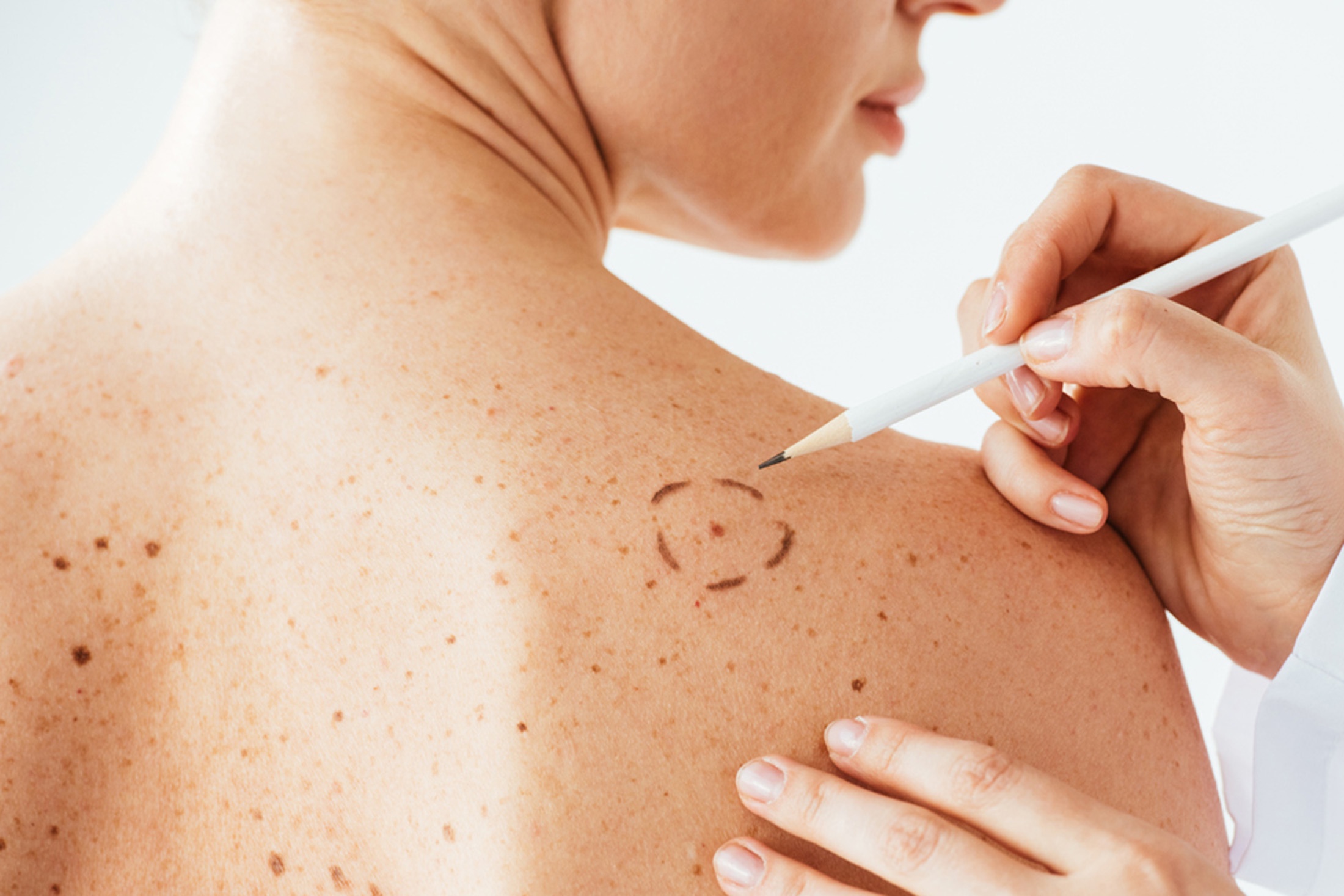
Recognizing Squamous Cell Carcinoma
- Appearance: Thickened red, scaly, or crusted spot; or a rapidly growing lump
- Behavior: Often bleeds, becomes inflamed, and is tender to touch
- Location: Usually on sun-exposed areas, but can appear anywhere on the body
Is SCC more dangerous than BCC? While both are typically treatable when caught early, SCC has a higher potential to spread, especially if located on the face. This underscores the importance of prompt medical attention for any suspicious growths.
Melanoma: The Most Serious Form of Skin Cancer
Although less common than BCC and SCC, melanoma is considered the most serious form of skin cancer due to its potential to spread rapidly if not detected early. It’s particularly concerning as it’s the most common cancer diagnosed in young Australians aged 12-24 years.
Spotting Melanoma
- Appearance: New spot or existing spot that changes in color, shape, or size
- Surface: Can be flat or raised with an irregular border
- Color: Often multi-colored
- Location: Can develop anywhere on the body, including areas not typically exposed to sun
How quickly can melanoma develop? Melanoma can evolve rapidly, sometimes changing noticeably over just a few weeks or months. This is why regular skin checks and awareness of any changes are crucial for early detection.
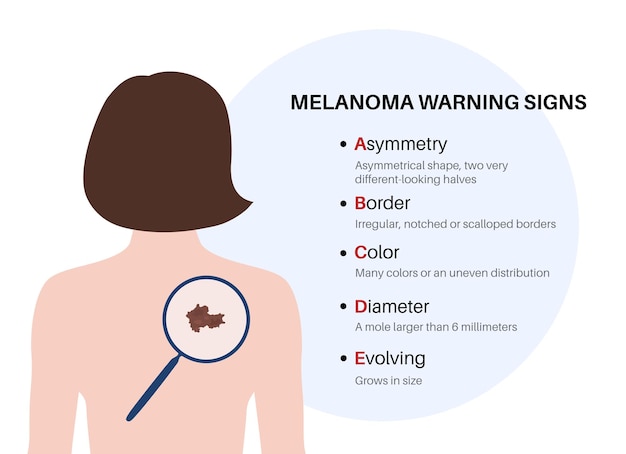
Nodular Melanoma: An Aggressive Subtype Requiring Immediate Attention
Nodular melanoma is a particularly aggressive form of melanoma that can spread quickly into deeper layers of skin. Early detection is critical for successful treatment.
Characteristics of Nodular Melanoma
- Appearance: Round, raised lump (dome-shaped nodule)
- Color: Pink, red, brown, or black
- Texture: Firm to touch, may develop a crusty surface that bleeds easily
Why is nodular melanoma so dangerous? Its rapid growth and tendency to invade deeper skin layers make it more likely to metastasize if not caught early. Any new, firm, dome-shaped growth that appears and grows quickly should be evaluated by a dermatologist as soon as possible.
Non-Cancerous Skin Growths: When to Monitor and When to Worry
Not all skin growths are cancerous, but some non-cancerous lesions can serve as indicators of increased skin cancer risk or potential warning signs. Understanding these benign growths can help you better monitor your skin health.
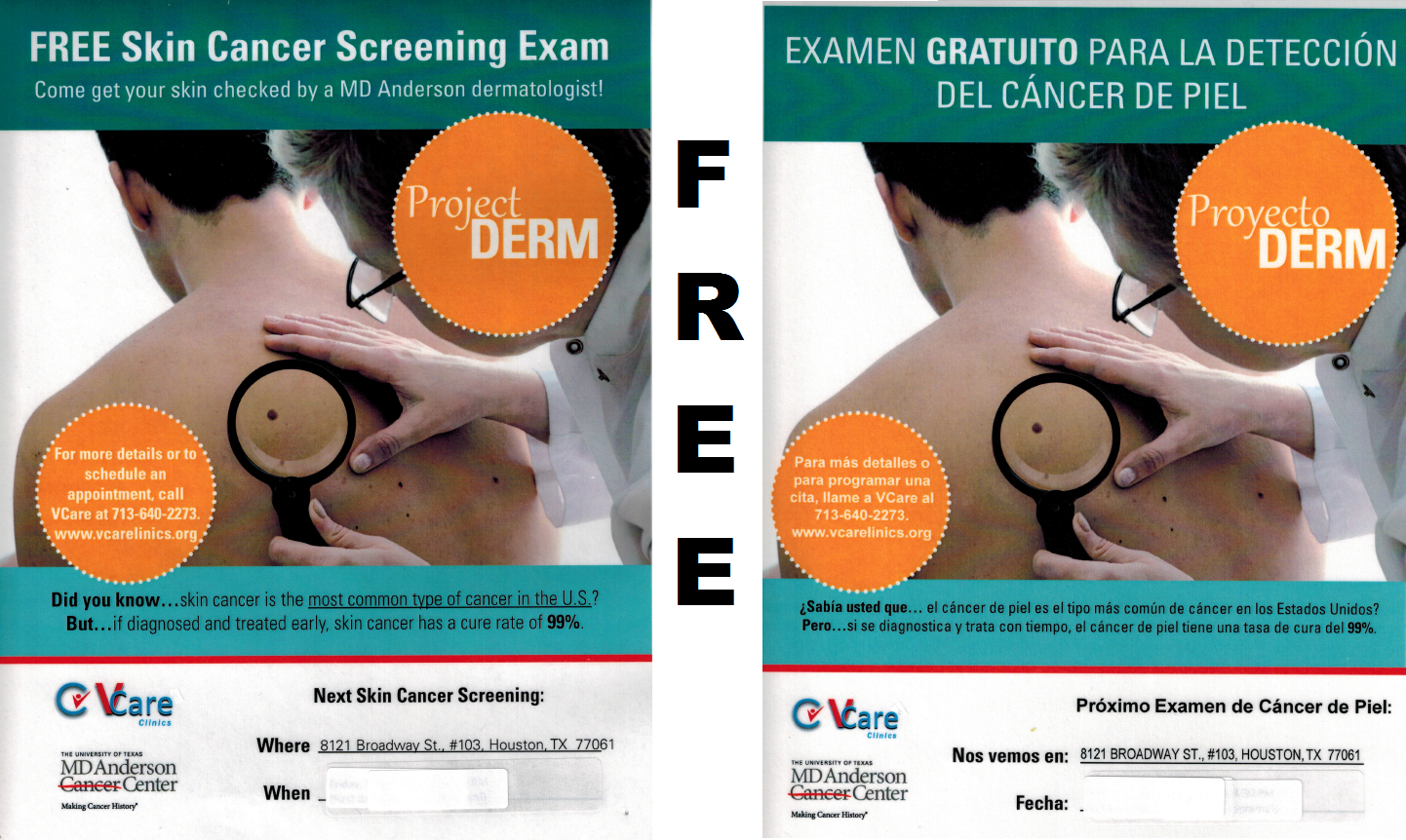
Common Moles
Moles are normal skin growths that are typically harmless. However, they should be monitored for changes.
- Appearance: Brown, black, or skin-colored with a defined oval shape
- Risk factor: Having many moles can increase melanoma risk
How often should you check your moles? It’s recommended to perform a thorough skin self-examination monthly, paying close attention to any moles that appear different from others or show signs of change.
Dysplastic Nevi
Dysplastic nevi, also known as atypical moles, have an irregular shape and uneven color. They require closer monitoring due to their slightly elevated risk of developing into melanoma.
- Appearance: Irregular shape and uneven color
- Risk factor: People with multiple dysplastic nevi have a higher risk of melanoma
Should all dysplastic nevi be removed? Not necessarily. While they have a slightly higher risk of becoming cancerous, most dysplastic nevi do not turn into melanoma. Regular monitoring and removal of any that show concerning changes is typically recommended.

The ABCDE Rule: A Simple Guide for Skin Cancer Detection
To help individuals recognize potential signs of skin cancer, dermatologists often recommend using the ABCDE rule when examining skin growths:
- Asymmetry: One half of the spot doesn’t match the other half
- Border: The edges are irregular, ragged, or blurred
- Color: The color is not uniform and may include shades of brown, black, or tan, with patches of red, white, or blue
- Diameter: The spot is larger than 6 millimeters across (about the size of a pencil eraser)
- Evolving: The spot is changing in size, shape, or color
Is the ABCDE rule foolproof? While it’s a useful guide, it’s important to note that not all skin cancers will exhibit all these characteristics. Some may only show one or two, while others (like certain melanomas) might not show any. This is why regular professional skin checks are important, especially for those at higher risk.
Risk Factors and Prevention Strategies for Skin Cancer
Understanding the risk factors for skin cancer can help individuals take proactive steps to protect their skin health. Some key risk factors include:

- Excessive sun exposure, especially during childhood
- Fair skin that burns easily
- Family history of skin cancer
- Personal history of skin cancer
- Weakened immune system
- Exposure to certain chemicals or radiation
How can you reduce your risk of skin cancer? Implementing sun-safe practices is crucial:
- Use broad-spectrum sunscreen with an SPF of at least 30
- Wear protective clothing, including wide-brimmed hats and sunglasses
- Seek shade, especially during peak sun hours (10 am to 4 pm)
- Avoid tanning beds
- Perform regular skin self-examinations
- Schedule annual skin checks with a dermatologist
Can lifestyle changes really make a difference in skin cancer risk? Absolutely. While some risk factors like genetics can’t be changed, adopting sun-safe habits and maintaining regular skin checks can significantly reduce your risk of developing skin cancer or catching it at an early, more treatable stage.
When to Seek Medical Attention: Trust Your Instincts
Given the potential seriousness of skin cancer, it’s crucial to know when to seek medical attention. As a general rule, you should consult a healthcare professional if you notice:

- A new spot on your skin
- A spot that looks different from others on your body
- A spot that has changed in size, shape, or color
- A sore that doesn’t heal within a few weeks
- A spot that itches, bleeds, or is painful
Is it better to err on the side of caution? When it comes to potential skin cancer, absolutely. Many people hesitate to see a doctor for fear of overreacting, but early detection can make a significant difference in treatment outcomes, especially for aggressive forms like melanoma.
The Importance of Regular Professional Skin Checks
While self-examinations are crucial, they should not replace regular professional skin checks. Dermatologists have the expertise and tools to detect subtle changes or concerning features that might not be apparent to the untrained eye.
How often should you have a professional skin check? For most people, an annual full-body skin examination is recommended. However, individuals with higher risk factors may need more frequent checks. Your dermatologist can advise on the appropriate schedule based on your personal risk profile.
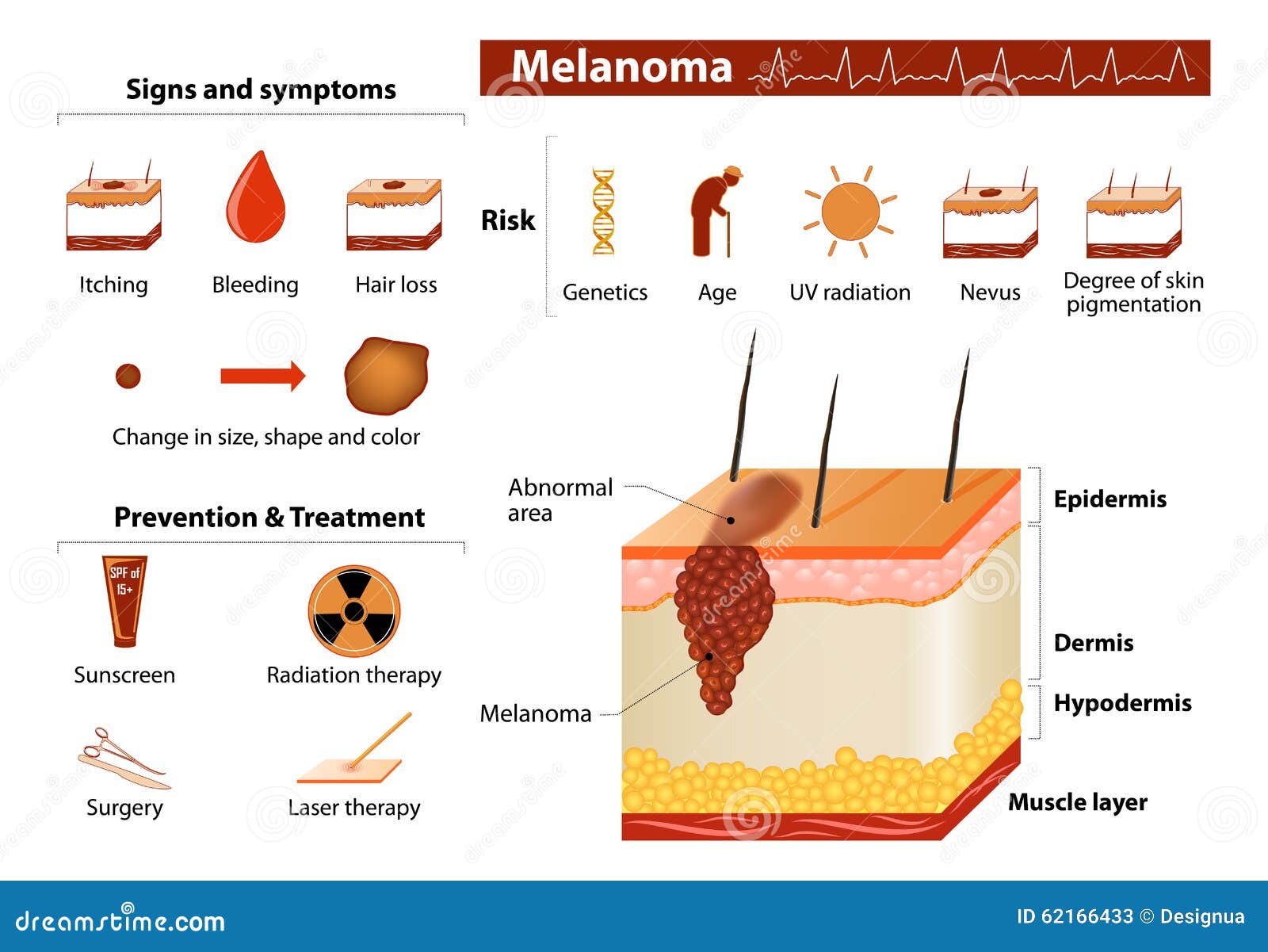
Advances in Skin Cancer Diagnosis and Treatment
The field of dermatology continues to advance, offering new hope for early detection and effective treatment of skin cancers. Some recent developments include:
- Dermoscopy: A non-invasive technique that allows for detailed examination of skin lesions
- Confocal microscopy: Provides real-time imaging of skin at a cellular level
- Artificial intelligence: AI algorithms are being developed to assist in skin cancer detection
- Immunotherapy: Harnessing the body’s immune system to fight advanced skin cancers
- Targeted therapies: Drugs that target specific genetic mutations in cancer cells
How are these advances changing the landscape of skin cancer management? These technologies and treatments are improving both the accuracy of diagnoses and the effectiveness of treatments, particularly for advanced cases. However, early detection remains the most crucial factor in successful outcomes.
The Role of Genetic Testing in Skin Cancer
For individuals with a strong family history of melanoma or multiple atypical moles, genetic testing may be recommended. Certain genetic mutations, such as those in the CDKN2A gene, can significantly increase a person’s lifetime risk of developing melanoma.
:max_bytes(150000):strip_icc()/hemoglobin-level-5211543-DD_Final-5839bd4fad49464584cc69c5460cb0eb.jpg)
Should everyone undergo genetic testing for skin cancer risk? Not necessarily. Genetic testing is typically reserved for individuals with specific risk factors or family history. A genetic counselor can help determine if such testing would be beneficial based on your personal and family medical history.
Living with Increased Skin Cancer Risk: Empowerment Through Knowledge
For individuals identified as having an increased risk of skin cancer, whether due to genetic factors, previous skin cancer diagnoses, or other risk factors, knowledge is power. Understanding your risk and taking proactive steps can significantly impact your long-term skin health.
Strategies for High-Risk Individuals
- More frequent skin checks, both self-examinations and professional evaluations
- Rigorous sun protection practices, including daily use of high-SPF sunscreen
- Consideration of protective clothing with built-in UV protection
- Possible use of oral supplements or topical treatments to support skin health
- Participation in skin cancer prevention clinical trials, when appropriate
Can lifestyle modifications truly make a difference for high-risk individuals? Absolutely. While having risk factors doesn’t guarantee you’ll develop skin cancer, taking these preventive measures can significantly reduce your chances and help ensure that if any issues do arise, they’re caught at the earliest possible stage.
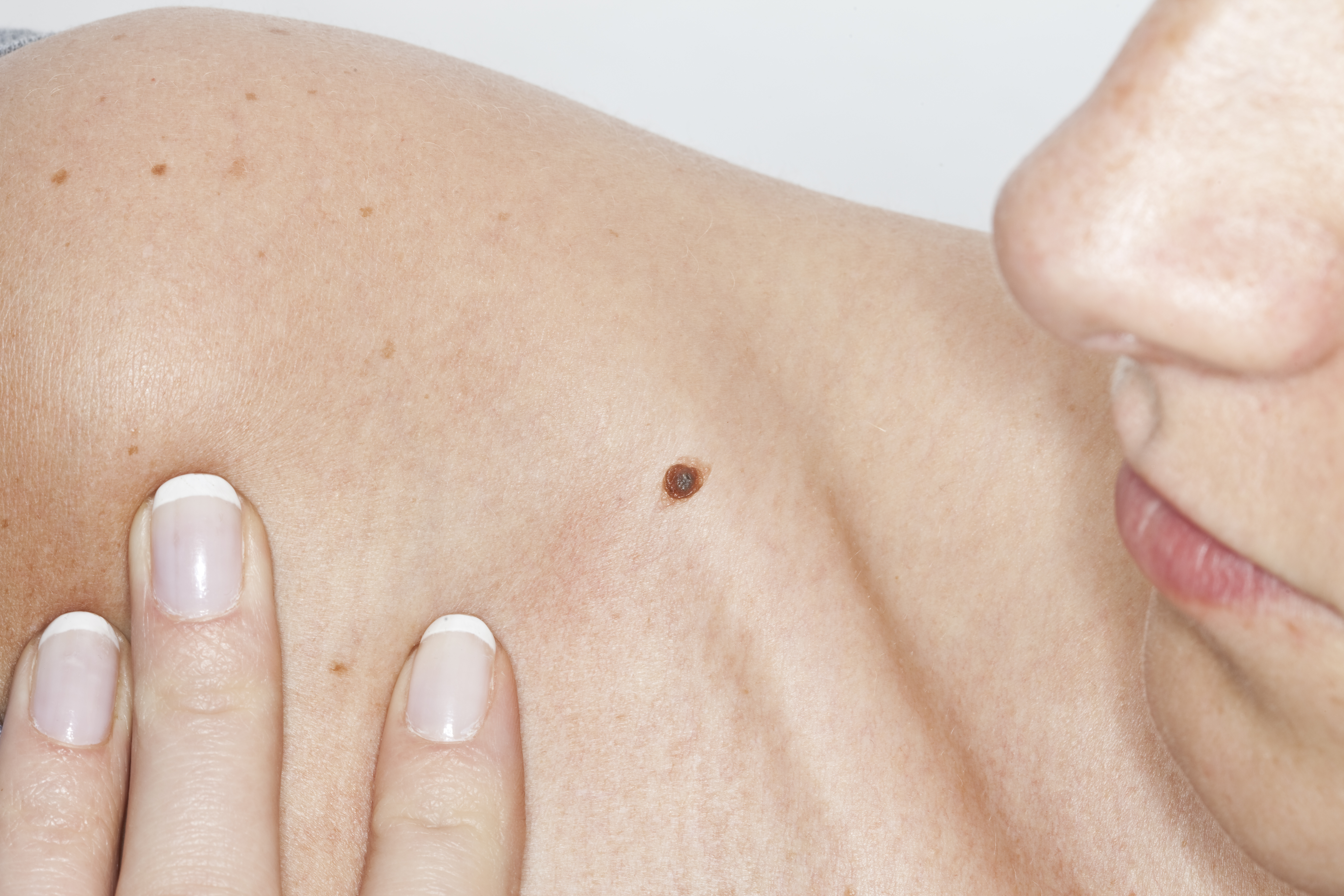
The Psychological Impact of Skin Cancer Risk
Living with an increased risk of skin cancer can be psychologically challenging. Some individuals may experience anxiety about their skin health or feel overwhelmed by the need for vigilant monitoring. It’s important to address these feelings and seek support when needed.
How can you maintain a positive outlook while managing skin cancer risk? Consider the following strategies:
- Educate yourself about skin cancer and prevention strategies
- Join support groups or online communities for individuals with similar concerns
- Practice mindfulness and stress-reduction techniques
- Focus on the aspects of your health you can control
- Celebrate your proactive approach to skin health
Remember, knowledge and proactive care are powerful tools in maintaining skin health. By staying informed and vigilant, you’re taking important steps to protect yourself and catch any potential issues early.
Skin cancer vs harmless spots: Do you know how to spot the difference?
What do skin cancers look like? Some spots on the skin are nothing to worry about, but others can be deadly if not detected and treated early. When it comes to the successful treatment of skin cancer—particularly melanoma— early detection is critical. To give yourself the best chance of catching skin cancer in its early stages, you need to know what to look out for.
There is no definitive description of what skin cancer looks like, so becoming familiar with your own skin and regularly self-checking your body for signs of change is the best way to catch skin cancer early. Keep an eye on spots that look different to others on your body, spots that have changed in size, shape, colour or texture, and sores that itch, bleed, or don’t heal. If you notice any of these signs, see your doctor and seek their expert opinion.
Types of cancerous spots
There are three common types of skin cancers—basal cell carcinoma, squamous cell carcinoma, and melanoma. What do these skin cancers look like? They can all look quite different. Below are some examples of each kind for your reference:
What do these skin cancers look like? They can all look quite different. Below are some examples of each kind for your reference:
Basal cell carcinoma
Basal cell carcinoma (BCC) accounts for about 70 per cent of all keratinocyte cancers (or non-melanoma skin cancer) diagnoses. These types of skin cancers grow slowly over months or years and having one BCC increases your risk of developing another.
BCC usually develops on sun-exposed areas, although they can appear anywhere on the body. You might first notice it as a pearly or shiny lump, or scaly area that is pale fleshy tone, pink or darker red in colour. This type of cancerous spot can become inflamed and ulcerate, and some seem to partially heal then flare up again.
See your doctor if you suspect you have a BCC.
Squamous cell carcinoma
Squamous cell carcinoma (SCC) accounts for about 30 per cent of remaining keratinocyte cancer diagnoses. These skin cancers can grow very quickly over the course of weeks or months, and are more common as you get older. Although rare, they do have the ability to spread if not treated early, particularly if on the face.
Although rare, they do have the ability to spread if not treated early, particularly if on the face.
SCC usually develops on sun-exposed areas, although they can appear anywhere on the body. You might first notice it as either a thickened red, scaly or crusted spot, or a rapidly-growing lump. You may notice this type of cancerous spot bleeds and becomes inflamed and is often tender to touch.
See your doctor if you suspect you have SCC.
Melanoma
Melanoma is not as common as BCC or SCC, but it is considered the most serious as it is more likely to spread if not caught early.
Melanoma can develop anywhere on the body, so it’s important to check those places not often exposed to the sun. You might first notice melanoma as a new spot or existing spot that has changed in colour, shape or size over several weeks or months. It can have either a flat or raised surface and may have an irregular border. Melanomas can also be more than one colour.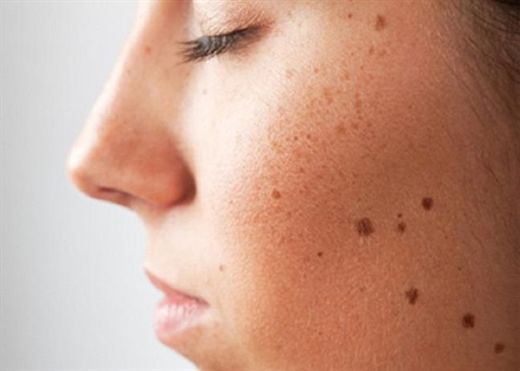
Despite being the least common type of skin cancer, melanoma causes the greatest number of skin cancer deaths and is the most common cancer diagnosed in young Australians aged 12-24 years.
See your doctor if you suspect you have a melanoma.
Nodular melanoma
This is a fast-growing and aggressive form of melanoma that can spread quickly into the lower layer of the skin and so early detection is particularly critical.
Nodular melanoma appears as a round, raised lump (dome-shaped nodule) on the surface of the skin that is pink, red, brown or black and feels firm to touch. It may develop a crusty surface that bleeds easily.
Don’t delay in seeing your doctor if you suspect you have a nodular melanoma.
Other skin spots to watch
There are a number of other skin spots that should not be ignored. Although they are non-cancerous, they may act as an indicator of increased risk or warning signs for skin cancer and should be monitored for changes.
Moles
Moles are very common, normal growths on the skin. If you have many moles on your body, it may run in your family, or you may have developed them as a result of increased time spent in the sun, particularly during childhood.
Moles are either brown, black, or skin coloured. They most often have a defined oval shape.
Moles have a small risk of developing into melanoma, however individuals with large number of moles are at greater risk of developing melanoma. Observe moles carefully for any sign of change.
Dysplastic naevi
A dysplastic naevus is a type of mole with an irregular shape and uneven colour. It may be known as an atypical naevus or mole. People with many of these spots have a greater risk of developing melanoma. It is particularly important to look for changes in dysplastic naevus as a small number of them may develop into melanoma.
If you suspect you have multiple dysplastic naevi, see your doctor about determining a suitable surveillance plan.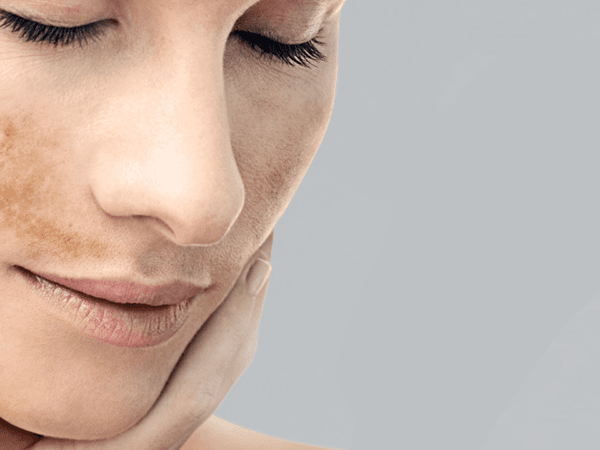
Solar keratosis
Solar keratoses also known as sunspots or actinic keratoses, are flat, scaly spots that feel rough to the touch and are either skin coloured or red. They are most common in people over 40 and on skin that’s often exposed to the sun.
Sunspots are a warning sign that you’ve spent too much time in the sun unprotected and may indicate that you have a higher risk of developing skin cancer in the future. If left untreated, can develop into squamous cell carcinoma.
See your doctor if you suspect you have sunspots to determine a suitable surveillance plan.
Seborrheic keratosis
A harmless spot with a discrete edge that looks like it sits on top of the skin or appear like a wart. Most people have at least one or two of these spots by the age of 60.
Seborrheic keratoses can vary in colour from pale brown to orange or black, and vary in size from a few millimetres to 20 millimetres.
Protecting your skin and your DNA from overexposure to UV radiation is the best way to reduce your skin cancer risk, as nearly all cases are caused by overexposure to UV, or spending ‘too much time in the sun’ unprotected.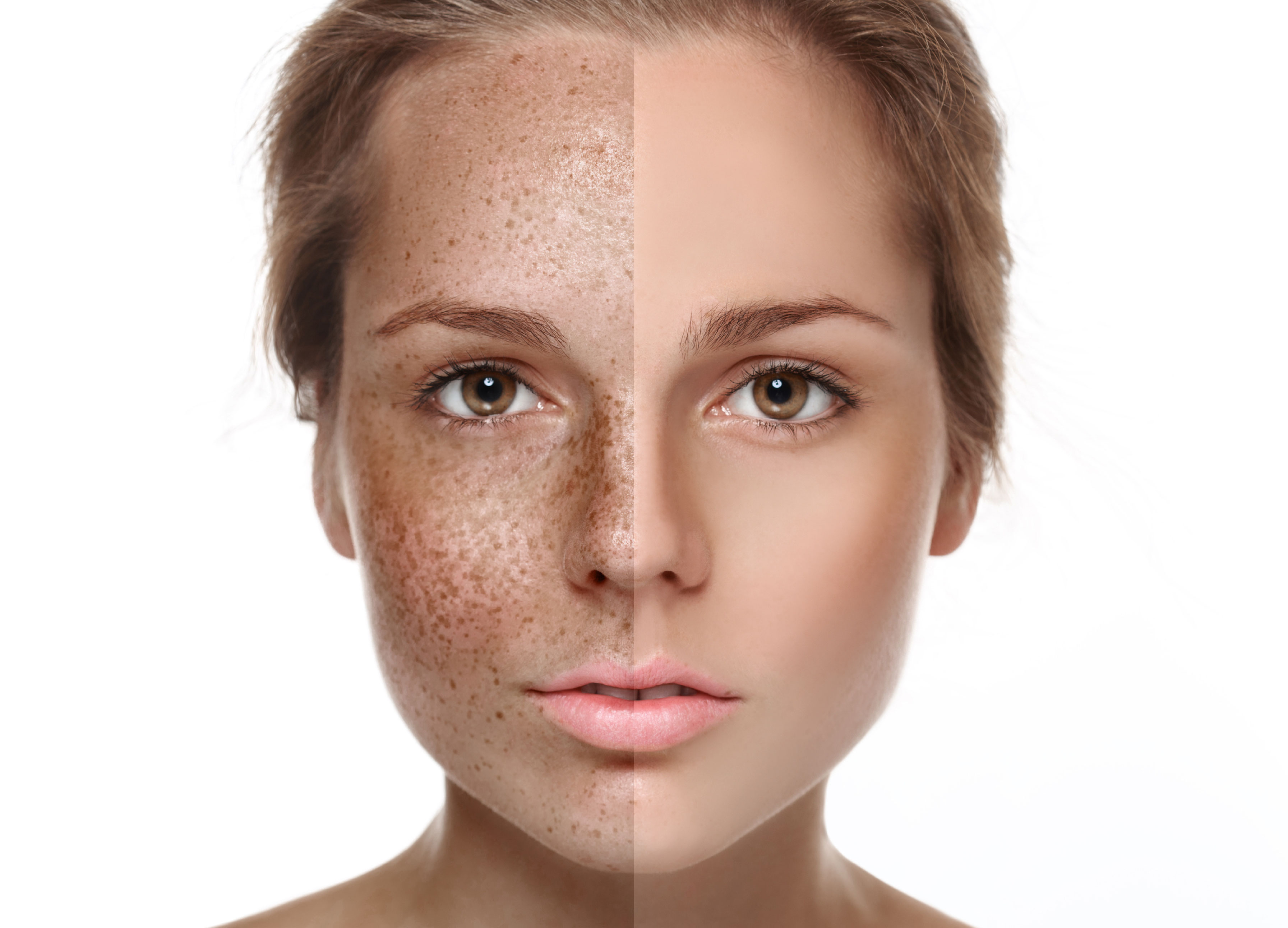 Damage from UV radiation adds up over time during our daily activities, often without us noticing which is why it is important to protect your skins DNA in five ways— slip, slop, slap, seek and slide—whenever you’re outside when the UV is 3 and above.
Damage from UV radiation adds up over time during our daily activities, often without us noticing which is why it is important to protect your skins DNA in five ways— slip, slop, slap, seek and slide—whenever you’re outside when the UV is 3 and above.
Learn more about how to check your skin for early signs of cancer, and follow Cancer Council SA over summer to learn more about UV radiation and skin cancer prevention.
Photos courtesy of Dr Gerry Considine and DermNet
How to Spot Skin Cancer
Published on:
April 9, 2020
Written by:
Stacy Simon
Senior Editor, News
Skin cancer is by far the most common type of cancer. If you know what to look for, you can spot warning signs of skin cancer early. Finding it early, when it’s small and has not spread, makes skin cancer much easier to treat.
Some doctors and other health care professionals include skin exams as part of routine health check-ups. Many doctors also recommend that you check your own skin about once a month. Look at your skin in a well-lit room in front of a full-length mirror. Use a hand-held mirror to look at areas that are hard to see.
Many doctors also recommend that you check your own skin about once a month. Look at your skin in a well-lit room in front of a full-length mirror. Use a hand-held mirror to look at areas that are hard to see.
Use the “ABCDE rule” to look for some of the common signs of melanoma, one of the deadliest forms of skin cancer:
Asymmetry
One part of a mole or birthmark doesn’t match the other.
Border
The edges are irregular, ragged, notched, or blurred.
Color
The color is not the same all over and may include shades of brown or black, sometimes with patches of pink, red, white, or blue.
Diameter
The spot is larger than ¼ inch across – about the size of a pencil eraser – although melanomas can sometimes be smaller than this.
Evolving
The mole is changing in size, shape, or color.
Basal and squamous cell skin cancers are more common than melanomas, but they are usually very treatable.
Both basal cell carcinomas and squamous cell carcinomas, or cancers, usually grow on parts of the body that get the most sun, such as the face, head, and neck.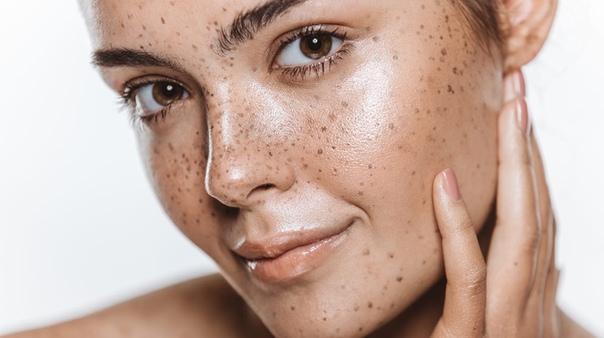 But they can show up anywhere.
But they can show up anywhere.
Basal cell carcinomas: what to look for:
- Flat, firm, pale or yellow areas, similar to a scar
- Raised reddish patches that might be itchy
- Small translucent, shiny, pearly bumps that are pink or red and which might have blue, brown, or black areas
- Pink growths with raised edges and a lower area in their center, which might have abnormal blood vessels spreading out like the spokes of a wheel
- Open sores (that may have oozing or crusted areas) and which don’t heal, or heal and then come back
Squamous cell carcinomas: what to look for:
- Rough or scaly red patches, which might crust or bleed
- Raised growths or lumps, sometimes with a lower area in the center
- Open sores (that may have oozing or crusted areas) and which don’t heal, or heal and then come back
- Wart-like growths
Not all skin cancers look like these descriptions, though. Point out anything you’re concerned about to your doctor, including:
- Any new spots
- Any spot that doesn’t look like others on your body
- Any sore that doesn’t heal
- Redness or new swelling beyond the border of a mole
- Color that spreads from the border of a spot into surrounding skin
- Itching, pain, or tenderness in an area that doesn’t go away or goes away then comes back
- Changes in the surface of a mole: oozing, scaliness, bleeding, or the appearance of a lump or bump
The American Cancer Society medical and editorial content team
Our team is made up of doctors and oncology certified nurses with deep knowledge of cancer care as well as journalists, editors, and translators with extensive experience in medical writing.
- Skin self-exam guide
- Images of skin cancer and non-cancer growths
American Cancer Society news stories are copyrighted material and are not intended to be used as press releases. For reprint requests, please see our Content Usage Policy.
Age spots on the face and body
Age spots on the face and body – causes of skin pigmentation and freckles, treatment, reviews, photos before after
Gift certificate purchase link
Our blog
All articles
Article updated on 05/28/2023
Contents
Issues addressed: skin pigmentation – white, brown pigment spots on the skin of the face, décolleté, hands. How to get rid of freckles?
This is a useful article. Thank you!
The reasons can be different, from excessive tanning to age-related changes.
Most often, our doctors deal with post-inflammatory skin pigmentation, such as age spots after acne, pimples and scars.
In second place is the work with pigmentation obtained after the sun or a solarium: lentigo, chloasma, melasma – all these are pigment spots arising from excess UV radiation.
Cosmetologist, chief physician
Ratkevich Marina Vladimirovna
Pigmented (white and dark) spots on the skin of the face can also form after operations, intensive peels and laser resurfacing, if there were violations in the process of skin care after the procedures.
Dark spots on the skin (melasma) may occur during pregnancy. At the same time, after the end of taking hormonal drugs, age spots often disappear on their own, but they can also return under the influence of the sun.
First of all, it is important to say: no technique can guarantee 100% that age spots on the skin will disappear forever. Many types of pigmentation are associated with chronic diseases of the liver and nervous system.
Cosmetologist
Borzenkova Anna Vladimirovna
However, there are well-established protocols to achieve a permanent whitening effect.
At the same time, a home skin care regimen with special products is a must. The doctor will select for you a whitening preparation for home care for 3-6 months. Don’t be surprised if your doctor asks you to get tested, because trace elements need to be tested to successfully treat pigmentation.
The results of the removal of age spots are especially noticeable after the phototherapy procedure on the Harmony-Pro device. No less effective are laser removal of age spots using Fraxel Re:store or Clear & Brilliant with applicator PERMEA (more about pigmentation treatment with laser C&B ).
Popular chemical peels are good for lightening superficial pigmentation. The compositions of peels are very diverse, from mandelic acid for moderate pigmentation to Jessner peel or retinoic peel (yellow peel) for deep pigmentation.
All doctors (8)
For pigmentation-prone skin, it is especially important to provide reliable sun protection all year round. To look perfect you will be helped by means that suppress the production of melatonin – sunscreen cosmetics TIZO .
To look perfect you will be helped by means that suppress the production of melatonin – sunscreen cosmetics TIZO .
In our clinic, doctors will select you products with a high active concentration of ingredients such as vitamin C and retinol . For example, the professional Canadian brand Rejudicare offers several retinol products in various0003
Preparation of the skin for the removal of age spots included home care for 2 weeks.
1) Daily care for pigmentation, which includes the following regimen:
– Whitening cream Illumin Cream RejudiCare is applied to pre-cleansed skin in the morning. Unlike other whitening products, the cream preserves the lipid barrier of the skin, that is, there is no need to add moisturizers to the care. After a month of application, the skin not only evens out in color, but also acquires a porcelain glow.
– In the evening, apply retinol cream Retinol SRX RejudiCare to the skin. The cream is very active, you need to apply it in the evening. It accelerates the exfoliation of cells, which allows you to quickly get rid of pigmentation, and also affects the formation of the pigment itself in the cells.
The cream is very active, you need to apply it in the evening. It accelerates the exfoliation of cells, which allows you to quickly get rid of pigmentation, and also affects the formation of the pigment itself in the cells.
2) Laser procedure Laser Clear & Brilliant with special applicator Permea .
3) If the patient wants to get rid of age spots as quickly as possible, the doctor may decide to use stronger methods of treatment Laser Fraxel ;
With a tendency to skin pigmentation – permanently. Age spots are formed during melanogenesis, and whitening cosmetics contain substances that act on different stages of this process.
For example, if you have chosen cosmetics with arbutin, then you can safely use it for about a year. A year later, it is necessary to change not only the line of cosmetics, but also the active substance itself. So you can influence the various stages of pigment formation in the skin.
Freckles give a unique charm, and many do not consider them a skin defect. But if the question “How to get rid of freckles?” is relevant for you, just use superficial peeling – AHA acids, salicylic peeling, etc. And, of course, provide good sun protection.
Read more
Treatment of age spots in Moscow at Versua Clinic, prices for treatment of pigmentation
Sign up for a procedure
We will contact you and clarify all the necessary details
I consent to the processing of personal data
Leave feedback
I consent to the processing of personal data
Ask a question
To be answered by Versua Clinic specialists
I consent to the processing of personal data
Age spots treatment
#Injection cosmetology#Hardware cosmetology#Care programs#Face
Share:
Articles
Age spots are benign formations that have an irregular shape and a non-uniform shade. In humans, they occur on the face and open areas of the body. Their appearance often worsens the appearance of the skin, contributes to the formation of complexes. Dermatologists from the Swiss rejuvenation center Versua Clinic in Moscow will tell about their types, causes and methods of dealing with an aesthetic defect.
Their appearance often worsens the appearance of the skin, contributes to the formation of complexes. Dermatologists from the Swiss rejuvenation center Versua Clinic in Moscow will tell about their types, causes and methods of dealing with an aesthetic defect.
What causes senile hyperpigmentation of the skin?
You may first encounter unattractive spots at the age of 55-60. These formations disturb patients for the following reasons:
- a feeling of neglect;
- emphasis on age;
- suspected risks of developing oncology.
Age-related pigmentation occurs only on exposed areas of the face and body that are repeatedly exposed to UV exposure. Their appearance is due to the following reasons:
- slow metabolism;
- presence of chronic systemic pathologies;
- hormonal disorders;
- violation of melanin transport.
Types of age-related hyperpigmentation of the skin
As a rule, the diameter of the formations does not exceed 1 cm. However, over the years they can increase, their number can also increase. Sometimes the surface of the spot becomes inhomogeneous. For example, crusts, roughness, plaques may appear on it.
However, over the years they can increase, their number can also increase. Sometimes the surface of the spot becomes inhomogeneous. For example, crusts, roughness, plaques may appear on it.
Raised dark brown patches most often appear:
- on the arms. You can observe them on the back of the hand;
- on the face. The formations are found on the temples, near the mouth,
- on the body. You can mark elements on the forearm, shoulders, neck, back.
There are two types of spots:
- lentigo is a hypermelanosis that occurs due to prolonged exposure to ultraviolet radiation on the skin. It appears as flat brown spots with blurred borders. This indicates damage to the deep layers of the skin;
- Keratosis is a skin disease that presents as brown to dark brown patches on the skin. They rise above the healthy epidermis, have a greasy surface, and are covered with horny scales. When treating pigmentation, it is important to consult with an oncologist regularly because of the risks of oncology.

How is age spots treated?
The method of therapy is chosen according to the clinical picture after a preliminary consultation with a cosmetologist. At the appointment, he will definitely collect an anamnesis. To eliminate risks to your health, special attention is paid to contraindications to a particular procedure. You may be recommended:
- phototherapy with M22. This is a hardware procedure, during which an impulse acts on the cells that produce melanin. After absorption, light energy is converted into heat. As a result, melanocytes are destroyed naturally. Treatment of age-related age spots on the skin using the M22 device allows you to get a lasting therapeutic effect. In this case, the shade of pigmentation and its size does not play a role. The result is noticeable from the first procedure, but it depends on the depth of the pigment, the size of the spot. A course of sessions is often required;
- photothermolysis on the Fraxel apparatus (“Fraxel”).
 Allows you to achieve a stable therapeutic effect in several procedures. Pigmentation treatment includes a course of 3-5 sessions. After treatment, the spots will darken, and then become lighter. A special nozzle of the installation breaks the beam into microbeams, arranged in a certain order. When treated by a competent doctor, the risks of burns are excluded;
Allows you to achieve a stable therapeutic effect in several procedures. Pigmentation treatment includes a course of 3-5 sessions. After treatment, the spots will darken, and then become lighter. A special nozzle of the installation breaks the beam into microbeams, arranged in a certain order. When treated by a competent doctor, the risks of burns are excluded; - mesotherapy. Treatment of age spots with this method of modern cosmetology is quite effective. It acts purposefully on the spot, activates blood circulation. The choice of a cocktail is carried out by the doctor on the basis of the clinical picture and the collected history. Mesotherapy is performed with preliminary local anesthesia. According to patients, this minimizes discomfort during injection. The rehabilitation period is minimal;
- peels. Azelaic, glycolic, mandelic acids effectively lighten age spots. They act on both superficial and deep layers of the skin. They start the renewal of epidermal cells.
 Peelings effectively even out skin tone, help to make other signs of age less pronounced. Treatment of age spots with peels is recommended if you have large enough lentigo spots. However, it should be passed in the autumn-winter period: at this time the sun becomes less active;
Peelings effectively even out skin tone, help to make other signs of age less pronounced. Treatment of age spots with peels is recommended if you have large enough lentigo spots. However, it should be passed in the autumn-winter period: at this time the sun becomes less active; - home care products. For example, your doctor may recommend cosmeceuticals with brightening, exfoliating effects, as well as products containing antioxidants. In the autumn-winter period, products with retinoids, derivatives of vitamin A, have proven themselves well. They slow down the transport of pigment in the skin, normalize cell renewal, activate keratogenesis, and work as conductors for other active ingredients. To avoid unwanted effects, the Versua Clinic cosmetologist will correctly select the percentage of retinoids in the product and the application scheme. As a rule, it is used at night. In the morning, it is extremely important to apply products with a high sun protection factor to the skin.
 It is important to understand that the work of retinoids is physiological. Therefore, you can notice the first result only after a month of regular use. It will take at least 6-8 months to achieve a lasting correction effect.
It is important to understand that the work of retinoids is physiological. Therefore, you can notice the first result only after a month of regular use. It will take at least 6-8 months to achieve a lasting correction effect.
After the procedure, do not forget to follow the rehabilitation rules that the doctor will tell you about. Use SPF regularly to help prevent new stains.
For the treatment of solar hyperkeratosis, contact the Swiss Rejuvenation Center Versua Clinic. You will be treated by doctors with extensive clinical experience.
List of sources
- https://cyberleninka.ru/article/n/seboreynyy-keratoz-klinicheskie-osobennosti-i-assotsiatsiya-s-virusom-papillomy-cheloveka-roda/viewer
- https://cyberleninka.ru/article/n/giperpigmentatsiya-kozhi-sovremennye-vzglyady-na-etiologiyu-i-pathogenez-chast-1/viewer
- https://cyberleninka.ru/article/n/seboreynyy-keratoz-kak-neizmennyy-sputnik-stareniya-sovremennyy-vzglyad-na-etiologiyu-i-patogenez/viewer
Estimate:
Liked (
)
Share:
Contents
What causes age-related hyperpigmentation of the skin? Types of age-related hyperpigmentation of the skin How is age spots treated? List of sources
Read more:
03/18/2021
Is it possible to do biorevitalization during menstruation
09/30/2015
Rules for preparing for laser hair removal
03/22/2017
Photorejuvenation.

 At the same time, a home skin care regimen with special products is a must. The doctor will select for you a whitening preparation for home care for 3-6 months. Don’t be surprised if your doctor asks you to get tested, because trace elements need to be tested to successfully treat pigmentation.
At the same time, a home skin care regimen with special products is a must. The doctor will select for you a whitening preparation for home care for 3-6 months. Don’t be surprised if your doctor asks you to get tested, because trace elements need to be tested to successfully treat pigmentation.
 Allows you to achieve a stable therapeutic effect in several procedures. Pigmentation treatment includes a course of 3-5 sessions. After treatment, the spots will darken, and then become lighter. A special nozzle of the installation breaks the beam into microbeams, arranged in a certain order. When treated by a competent doctor, the risks of burns are excluded;
Allows you to achieve a stable therapeutic effect in several procedures. Pigmentation treatment includes a course of 3-5 sessions. After treatment, the spots will darken, and then become lighter. A special nozzle of the installation breaks the beam into microbeams, arranged in a certain order. When treated by a competent doctor, the risks of burns are excluded; Peelings effectively even out skin tone, help to make other signs of age less pronounced. Treatment of age spots with peels is recommended if you have large enough lentigo spots. However, it should be passed in the autumn-winter period: at this time the sun becomes less active;
Peelings effectively even out skin tone, help to make other signs of age less pronounced. Treatment of age spots with peels is recommended if you have large enough lentigo spots. However, it should be passed in the autumn-winter period: at this time the sun becomes less active;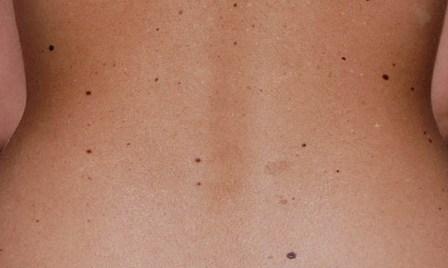 It is important to understand that the work of retinoids is physiological. Therefore, you can notice the first result only after a month of regular use. It will take at least 6-8 months to achieve a lasting correction effect.
It is important to understand that the work of retinoids is physiological. Therefore, you can notice the first result only after a month of regular use. It will take at least 6-8 months to achieve a lasting correction effect.